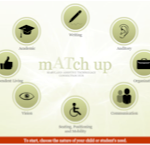September is upon us, and for many that means the beginning of a new school year. Teachers, students and parents are once again working together to make this academic year the best yet. For those supporting students under the Individuals with Disabilities Education Act (IDEA), their cornerstone to success is the Individualized Education Program (IEP). This unique plan of services is developed by the IEP team to help the student be involved and progress in the general curriculum.
Did you know assistive technology (AT) can be a means to student success? It can, and for that reason AT must be considered for each child during IEP development! To help IEP teams consider AT options in a comprehensive, systematic fashion, the Maryland Department of Education, in collaboration with Johns Hopkins University developed the Matchup tool. I have found it to be a great starting point for IEP teams, new to or experienced in considering AT, and hope you will too.

How does it work? It is intuitive and simple! To begin, the team selects from eight identified need areas. Once the need area is selected, a new page opens further dividing the need into a subset of of necessary skills. The team then selects the skill subset needing attention, and a range of AT options are provided from no/low tech to high tech. For example:
- The need area selected is WRITING.
- The subset selected is MECHANICS/SPELLING/EDITING.
- The AT options offered are HIGHLIGHTING TAPE/PEN (low/tech) to GHOTIT, a Microsoft Office add-in that provides spell check and grammar check functions based on context (high tech).

Really great article and too often AT is overlooked for reasons I won’t go into.
Thought I might try to piggy-back with something that is also often times overlooked on the IEP and something which has made a difference to me and to my clients (Parent of a child diagnosed with PDD-NOS also and 10+ years as a professional special needs advocate). Creating some minimal weekly consultative time for teachers or support personnel to connect to each other and to parents is important. Parents usually feel strongly that the issues and activities which happen at home impact the education at school and vice-versa so you would think every IEP would naturally have some minimal time to synch up parents and teachers on a weekly basis. I rarely find this to be the case.